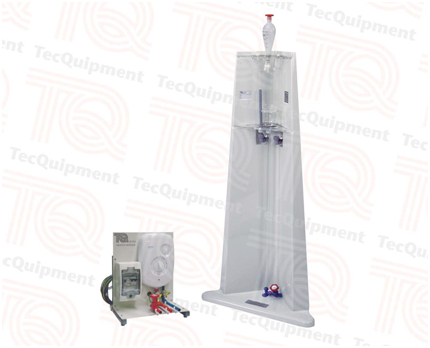General Test Procedures
For normal demonstrations a controlled supply of coldwater from the laboratory can be used. Details of how touse the temperature control module are given later inthis section.
The basic procedure, which can be used for all tests,demonstrates how the conditions in the pipe vary withflow velocity and that the changes occur over a range ofvelocity (and therefore of Reynolds number). TheReynolds number can be calculated for cach conditionfrom the pipe diameter,velocity and the viscosity ofwater for the particular temperature of test. Samplecalculations are given later in this scction. The basicprocedure is as follows:
Set up the apparatus as previously described, turn on the water supply,and partially open thedischarge valve at the base of the apparatus.
Adjust the water supply until the level in the constant head tank is just above the overflow pipeand is maintained at this level by a small flow downthe overflow pipe.This is the condition required forall tests and at different flow rates through the tube;the supply will need to be adjusted to maintain it.At any given condition the overflow should only bejust sufficient to maintain a constant head in thetank.
Open and adjust the dye injector valve to obtain afine filament of dye in the flow down the glasstube. If the dye is dispersed in the tube reduced thewater flow rate by closing the discharge valve andadjusting the supply as necessary to maintain theconstant head. A laminar flow condition should beachieved in which the filament of dye passes downthe complete length of the tube without disturbance.
slowly increase the flow rate by opening thedischarge valve until disturbances of the dyefilament are noted (see Figure 4b). This can beregarded as the starting point of transition toturbulent flow. Increase the water supply asrequired to maintain constant head conditions.
Record the temperature of the water using thethermomcter, then measure the flow rate by timingthe collection of a known quantity of water fromthe discharge pipe.
Further increase the flow rate as described aboveuntil the disturbances increase such that the dyefilament becomes rapidly diffused as shown inFigure 4c. Small eddies will be noted just above thepoint where the dye filament completely breaksdown. This can be regarded as the onset of fullyturbulent flow. Record the temperature and flowrate as in step (5).
Now decrease the flow rate slowly until the dye justreturns to a steady filament representing laminar flow and again record the temperature and flowrate.


